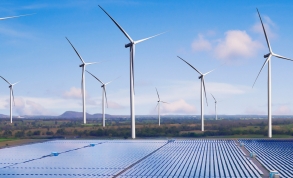Abstract
After joining the European Union (EU), Romania was required to meet the EU standards for air quality and greenhouse gas (GHG) emissions. Meeting these standards for GHG emissions was effective in reducing emissions by an average of one million tonnes annually between 2007 and 2014.
Intervention overview
After joining the EU, Romania was required to implement policies to reduce GHG emissions to meet EU standards. Most of the GHG emissions in Romania are from energy production. In 2014, 68.17 million tonnes of CO2 were emitted, of which 27.3 million tonnes were from the energy sector. Romania was also required to adhere to the EU’s strict air quality standards - which included mitigating emissions of pollutants at source, yearly outflow constraints for specific pollutants, and targeting sectors that were major sources of air pollution - to improve their energy consumption.
In 2014, 44% of Romania's renewable electricity was generated from hydroelectricity (94% in 1990), 27% from wind (0% in 1990), 18% from biomass (4% in 1990), 11% from solar (0% in 1990), and 1% from geothermal power (1% in 1990). This increase in renewable sources of energy replacing fossil fuels, in addition to policies to improve air quality, resulted in air pollution reductions.
Outcomes
While the amount of electricity produced in Romania increased from 56.69 TWh (Terawatt hours) in 2009 to 61.8 TWh in 2016, CO2 emissions from its production decreased from 25.36 million tonnes of CO2 in 2009 to 17.74 million tonnes of CO2 - a reduction of 7.62 million tonnes in 7 years, or an average of 1 million tonnes annually.
Potential impact and feasibility of scale-up
In 2020, 12.4% of the electricity production in Romania came from wind power and 3.4% came from photovoltaic solar panels for a total of 16% from renewable energy production. If all electricity production in Romania were derived from renewable energy sources, there would be potential savings of 6.25 million tonnes of CO2 annually, accounting for approximately 9% of the country's total CO2 emissions. Factors enabling this transition included government schemes which assisted wind and solar electricity producers and reductions in manufacturing costs, achieved by renewable energy technologies, such as photovoltaics.
GHG emissions from fossil fuels fell drastically since the 1990s, due to major changes in the economy. Emissions fell significantly in 2009 thanks to the economic crisis and the EU’s strict air quality standards (these included mitigating emissions of pollutants at source, yearly outflow constraints for specific pollutants, and targeting sectors that are major sources of air pollution to improve energy consumption). The application of an air quality law has remained a challenge because of poor coordination and planning of the administrative mechanisms, and due to low attainment of EU funds. Lack of effective policies on air quality results in many companies not adhering to air quality control regulations.
Although this study has shown reductions in GHG emissions and improvements in air quality, more information on which government schemes have helped wind and solar electricity would shed light on the facilitators that aid scale-up. In addition, a more thorough analysis of the economic changes that resulted in the fall in fossil fuel use could provide insight into what would help sustain or achieve further reductions.
Radu Dudău and Mihnea Cătuţi, writing for the Leibniz Information Centre for Economics, analysed the decarbonisation challenge in Romania. The first official Romanian energy strategy document was produced in 2007, for the period up to 2020. The strategy was aimed at adhering to the requirements associated with joining the EU, so energy and climate plans were specific to the sectors where EU requirements demanded them and to the EU GHG reduction targets; the Romanian government did not pass any climate policies beyond those required by the EU. In addition, the strategy document was challenged and invalidated by the World Wildlife Fund for its failure to incorporate a strategic environmental analysis. In 2018, a new government in Romania produced a strategy document for further decarbonisation of the energy sector. Dudău and Cătuţi note that, at the time of their analysis, this strategy was based on projects that were not yet underway and that the document again lacked a strategic environmental analysis and included unambitious climate targets.
In addition to insufficient government commitment to decarbonisation, barriers to the reform of Romanian energy markets exist. These include a lack of installed energy capacity, requiring the importation of energy to cover demand; a lack of investment in new renewable power plants, largely due to the absence of policy or investment incentives; and continuing state aid to the coal sector to prevent the collapse of the coal industry, which was burdened by the price hike of the EU CO2 allowances (Dudău and Cătuţi, 2019).
References
Academic profile / relevant organisation’s page
- Năstase, G., Șerban, A., Năstase, A. F., Dragomir, G., & Brezeanu, A. I. (2018). Air quality, primary air pollutants and ambient concentrations inventory for Romania. Atmospheric Environment, 184, 292-303. Available online: https://www.sciencedirect.com/science/article/pii/S1352231018302656
Supplementary information
- Dudău, R., & Cătuţi, M. (2019). The decarbonisation challenge of southeast Europe: A case study of Romania. Intereconomics, 54(6), 341-346. Available online: https://link.springer.com/article/10.1007/s10272-019-0851-y



